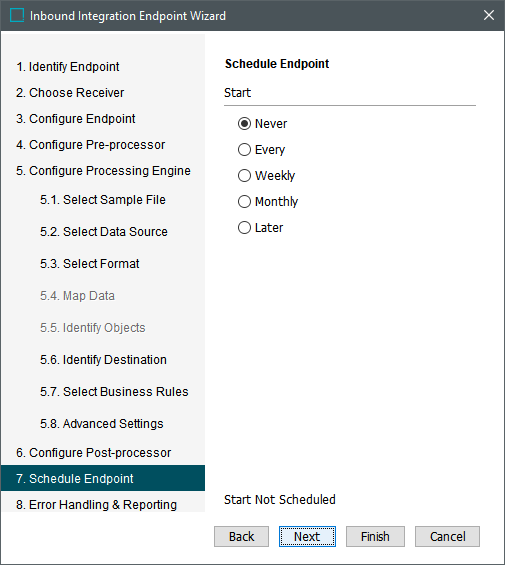
The Kafka Streaming Receiver does not use a schedule or the invoke options in the workbench or via REST. Instead, enabling the IIEP starts the streaming threads and disabling the IIEP stops the streaming threads. Refer to the Kafka Streaming Receiver topic for details.
Use Schedule Endpoint to specify how often the endpoint should search for data to be processed considering the following:
- IIEPs that do not use the REST Receiver method should typically be scheduled to poll the data source for new files / messages with regular intervals.
- IIEPs that do use the REST Receiver method can be invoked via a REST POST request. With this functionality, for example, a system delivering data to STEP could potentially invoke the IIEP after having uploaded a file to a Hotfolder. For more information, refer to the REST Receiver topic.
Important: Consider the time zone of the application server compared to that of the workbench (the client) where the schedule is created or viewed. When scheduling a job, the local time zone is displayed in the workbench, but the time zone of the server is used to run the background process. Although displayed, the time zone of the client is not included in the instructions to the server to run the job. This can cause confusion about when the job will run since the scheduled time is not automatically converted to accommodate potential differences in time zones.
-
Choose a radio button to select the necessary schedule:
-
Never - invoke the endpoint manually, no additional parameters are required, and no schedule is applied. This is the default setting and should be used while testing your endpoint.
-
Every - automatically run the endpoint repeatedly, every selected number of minutes. One (1) minute is the shortest interval allowed and is closest to real time. Enter the number of minutes in the text box. The selection is summarized at the bottom of the dialog.
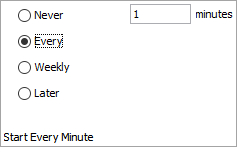
-
Weekly - automatically run the endpoint repeatedly, based on the selected time, start and end dates, and days of the week. Use this option if a daily schedule is needed. The 'Start at' parameter determines the time of day that the endpoint will run. The 'Start on' parameter determines the date the endpoint will first run, while the 'End on' parameter determines the date of the endpoint's final run. The 'Every' checkboxes determine the days of the week when the endpoint will run. The selections are summarized at the bottom of the dialog.
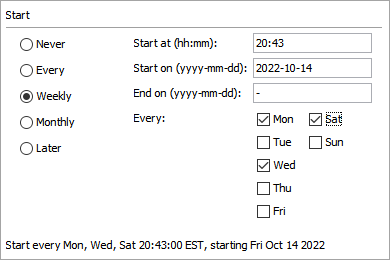
-
Monthly - automatically run the endpoint repeatedly, once a month, based on the selected time, start and end dates, week of the month, and day of the week. The 'Start at' parameter determines the time of day that the endpoint will run. The 'Start on' parameter determines the date the endpoint will first run, while the 'End on' parameter determines the date of the endpoint's final run. The 'Every' dropdown parameter selections for the week of the month and the day of the week determine when the endpoint will run. The selections are summarized at the bottom of the dialog.
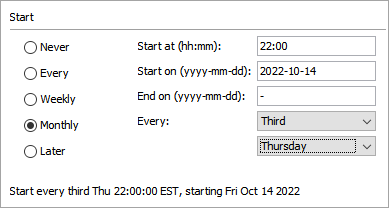
-
Later - automatically run the endpoint only once, at the time and date specified. The selections are summarized at the bottom of the dialog.
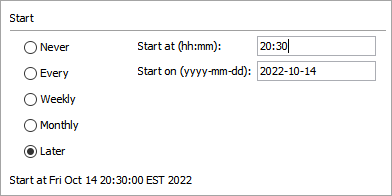
-
Important: When changing the schedule of an IEP, it is recommended to disable the IEP, update the schedule, and then re-enable the IEP to ensure the schedule change is correctly applied. Otherwise, the schedule change might cause the IEP to initially run at an incorrect time. For example, if an IEP is originally scheduled to run daily at 6 p.m. and the schedule is changed to 7 p.m., the next execution might still occur at 6 p.m. At this time, the schedule is updated on the BGP, resulting in another run at 7 p.m., as the updated schedule is applied when the IEP is either manually or automatically invoked, or when it is restarted.